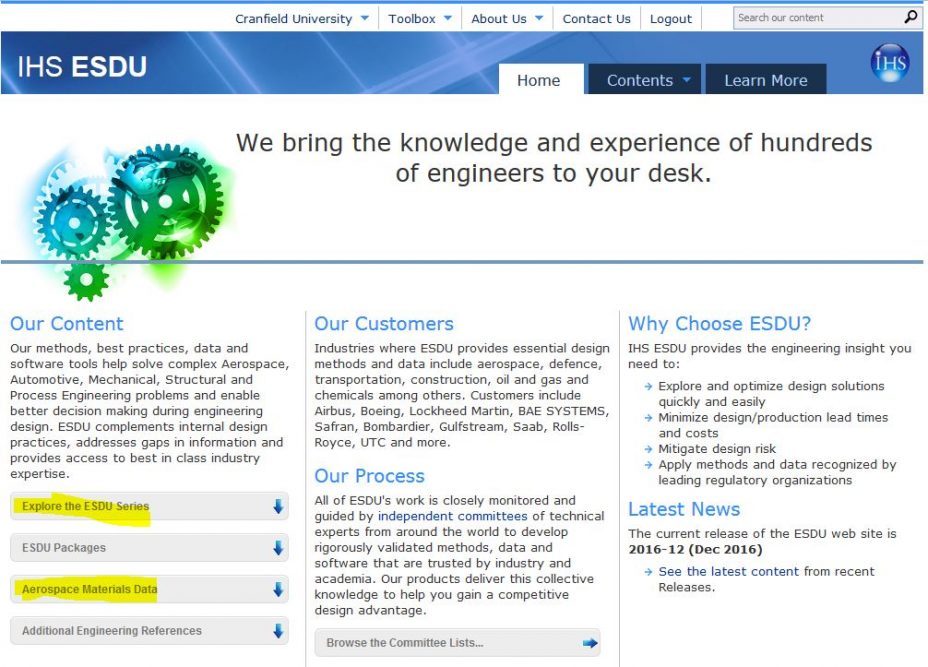ESDU – a fantastic resource for engineers!
07/12/2016

This is the first of a series of blog posts in which we will highlight some of our more specialist resources for engineers.
This one is all about ESDU. If you’re the kind of person who needs to find out how to calculate the strength of lugs under oblique load, or the lift-curve slope of swept and tapered wings, ESDU is the resource for you. It really is one of our ‘hidden gems’. It’s one of my favourite resources as it has helped me answer many tricky enquiries, and it gets such a great response when customers find the solution to their engineering design problem on it.
When I first started my Cranfield working life in the Kings Norton Library, ESDU stood for ‘Engineering Sciences Data Unit’ and comprised thousands of ‘data sheets’ which were filed away in hundreds of ring binders. Each time there was an update to a data sheet, ESDU sent us a new one and we would laboriously find the old version, throw it out and replace it with the new. Thankfully times have moved on and the service is now available online and is always up to date.
It contains fantastic information for engineers that really isn’t available elsewhere, and certainly not for free via a Google search. It’s a great place to go if you have an engineering problem that you want to solve, and it can save you lots of time and research by providing methods, worked examples and data. Its work is overseen by independent committees of technical experts (some of whom work at Cranfield), and is endorsed by the Royal Aeronautical Society, the Institution of Mechanical Engineers and the Institution of Chemical Engineers.
It contains equations, interactive graphs and software organised into 18 series. Experience has shown me that the best way to find what you need is to select the ‘Explore the ESDU series’ option and then browse to the information that you need.

‘Explore the ESDU Series’ and ‘Aerospace Materials Data’ options highlighted on the ESDU home page
The series are: aerodyamics, aircraft noise, composites, dynamics, fatigue – endurance data, fatigue – fracture mechanics, fluid mechanics (internal flow), fluid mechanics (internal flow – aerospace), heat transfer, mechanisms, performance, phyiscal data (chemical engineering), stress and strength, structures, transonic aerodynamics, tribology, vibration and acoustic fatigue and wind engineering.
Alongside the data sheets is another handy resource. The Metallic Materials Data Handbook (MMDH) can be found behind the ‘Aerospace Materials Data’ link and is a great source of metals property data for aerospace engineers, bringing lots of information that has been evaluated and meets design requirements together in one place.
ESDU itself provides videos and help and I am always happy to advise you and answer your questions. Contact me at e.turner@cranfield.ac.uk.
Public domain image from Unsplash.com
Categories & Tags:
Leave a comment on this post:
You might also like…
Study better and smarter in 2026
Happy new year! Now is the perfect time to reflect on your studies so far, thinking about what you’re doing well and where you need to focus a bit more attention. Getting back into ‘study ...
Cleared for the future: Why aviation leaders must embrace environmental sustainability
Environmental sustainability is not a niche concern for aviation anymore, it’s central to how we think about the future of our industry. In my work as an Associate Professor of Airport Decarbonisation, I see first-hand ...
Preparing your work for Turnitin submission
Before submitting your work into Turnitin for similarity checking, if you have used referencing software then you may need to take some important steps first. Mendeley and Zotero integrate with MS Word by embedding field ...
The fast track to supercar engineering: My Cranfield journey
It’s been a dream come true to work on some of the world’s most prestigious supercars – the Aston Martin Valhalla, McLaren 750 & Artura, the GMA T.33. But every successful ...
Automotive Engineering: From student to hypercar innovation at Rimac
We sat down with recent graduate Thomas Perrin, to discuss how his year on the MSc in Automotive Engineering at Cranfield University propelled him from the lecture hall directly into the ...
What this year at Cranfield really meant to me
Every Cranfield journey is unique. In this alumni reflection, Zachea Scicluna shares what her year at Cranfield truly meant, from facing uncertainty to gaining hands-on experience in industry-backed projects. I’ve been reflecting (and delaying) ...






